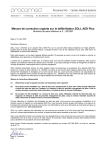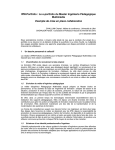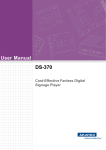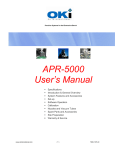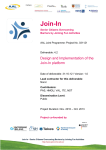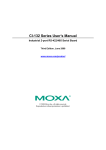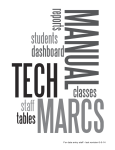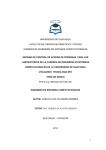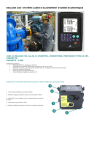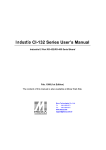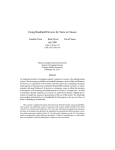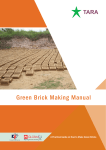Download D7.3 Appendix C final EC
Transcript
Appendix C: Transferability Questionnaires Table of Contents Transferability Questions for LTfLL Team: WP 4.1.......................................................................... 2 Transferability Questions for LTfLL Team: WP 4.2.......................................................................... 8 Transferability Questions for LTfLL Team: WP 5.1........................................................................ 13 Transferability Questions for LTfLL Team: WP 5.2........................................................................ 19 Transferability Questions for LTfLL Team: WP 6.1........................................................................ 24 Transferability Questions for LTfLL Team: WP 6.2........................................................................ 29 D7.3 Appendix C: Transferability questionnaires Page 1 of 35 Transferability Questions for LTfLL Team: WP 4.1 Part 1: Institutional policies and practices 1. While preparing for, or during the pilot, did you become aware of any policies or practices in the pilot institution(s) that may affect their acceptance/willingness to implement of the service? e.g. BlackBoard as corporate VLE. Please name the pilot institution to which each of the mentioned policies/practices refers. 2. Instituti on Policy or practice BITMEDIA Policy or practice: BITMEDIA is using different LMS – e.g. SITOS (bitmedia product) Could the difficulty be overcome, and if so, how? Elgg can be used for running the WP 4.1 services Timing (please underline): during Round 3 WUW Policy or practice: WUW is using OpenACS/DotLRN; Requires implementation as an OpenACS module Could the difficulty be overcome, and if so, how? Yes, build an OpenACS module that encapsulates the webservices or reference to external Elgg-based or standalone webservice Timing (please underline): during Round 3 UTU Policy or practice: UTU has been one of the main contributors to the service design and has developed the Language Technologies underlying the qualitative and quantitative analysis and the collection of relevant training texts( i.e. corpus building) Could the difficulty be overcome, and if so, how? We have implemented the Language Technologies as Java routines. We have designed a set of procedures for optimally building training data sets, training/initialising , and verifying/testing those Technologies. Timing (please underline): during Round 3 If you think about other institutions, can you suggest any other policies or practices likely to affect the success of attempts to transfer the software to them? Policy or practice Policy or practice (1): The learners are not familiar with language technologies and regarding possibilities. Therefore some of the learners do not trust the system immediately. Could the difficulty be overcome, and if so, how? To avoid this issue the learners have to be introduced to the Positioning System and the underlying language technologies. This additional effort has to be calculated for the use of the system in new environments. Part 2: Relevance of the service in other pedagogic settings D7.3 Appendix C: Transferability questionnaires Page 2 of 35 Pedagogic settings = self-directed learning, directed learning, social learning, solo learning…. etc. PBL, essay writing, discussion forums, student projects, work-based learning, revising for exams… etc. 3. From your knowledge of the underlying pedagogic theory, can you suggest pedagogic settings for which the service would be more, or less, suitable. Please give reasons. Pedagogic setting Pedagogic settings for which the service would be suitable: Setting1: Using the Positioning Service in a self-directed learning environment. Setting 2: Using the Positioning Service in vocational education and training. Setting 3: Using the Positioning Service in secondary schools. Reason(s) The live-feedback provided by the service provides phrases as results, which are useful in combination with other LTfLL services and internet search technologies. This feedback motivates the learners to find learning materials. The optimization of the learning for their employees (reduce time and motivate the participants) is very important for the companies. To provide a solution for this issue as a important request, which the education companies have to solve. The service can be added as additional method for motivating and positioning the pupils for specific domains (physics, chemistry and history – domains where the learners have different existing knowledge). If the learner is not familiar with computer systems he is not able to focus on the requested information in the questionnaire (the learner is stressed by using the computer). Using the computer environment is not the difficulty for these pupils, but they don’t have enough existing knowledge to provide useful answers to the system. Pedagogic settings for which the service would be less suitable: Setting 1: The Positioning Service is not useful for individuals with none or less experience in using computers. Setting 2: Using the Positioning Service in primary school environments. Part 3: Relevance of the service in other domains 4. From your knowledge of the underlying pedagogic theory, can you suggest types of domain for which the service would be more, or less, suitable. Please give reasons. Types of domain Types of domain for which the service would be suitable: Reason(s) Setting 1: The Positioning Service is useful in domains where descriptive texts are used to answer The used language technologies are not limited to a specific domain. D7.3 Appendix C: Transferability questionnaires Page 3 of 35 questions. Even if there are no unique answers available the Positioning Service is able to provide useful feedback. (e.g. physics, chemistry,…) Types of domain for which the service would be less suitable: Setting 1: The Positioning Service is not useful for domains with unique answers (e.g. mathematics, physics,…) For these domains better positioning results can be achieved by other systems (e.g. multiple choice testing). Part 4: Effort involved in setting up the system In answering Question 5, think about an institution without previous experience of the LTfLL service. 5. What steps are needed to install and configure the system in a new environment? Add additional rows to the table, as required. List each step briefly (in a few words), e.g. "run installation script", "select <language> lexicon, e.g. Bulgarian" Topic Step How long will this take? e.g. a few person-hours, a week, a month, several weeks/months etc. Training and documentation – system set-up List the initial training topics for the technical support team, to prepare them for setting up the system. 1. Install the background servers and software prerequisites (for the language technologies). 2. Install the WP 4.1 front end system. Training time: 1 day List the initial training topics for the tutors, to prepare them for performing the initial set-up of the system. 1. Introduce to language technologies 2. Explanation and training of the user interface 3. Guidelines on building new semantic spaces and training corpora for new courses/domains Training time: 0,5 days What documents will be provided at the end of the LTfLL project to assist with system set-up? 1. Positioning Service Installation Guide 2. Screencast videos to introduce to the service – the administrators are able to test the functionality of the service. 3. Initial Configuration Guide. Not applicable D7.3 Appendix C: Transferability questionnaires Page 4 of 35 Topic Step How long will this take? e.g. a few person-hours, a week, a month, several weeks/months etc. Selecting appropriate language technology data sources Lexicons, ontologies etc. What language technology data sources have to be selected? 1. Generic corpora for each language 2. Domain specific documents/corpora 3. Learning material 4. Graded learner texts for defined questions/topics Time: Preparing local data for 'gold standard' or reference model List the steps required for preparing local 'gold standard'/reference model data. Include what type of local data, if any, will be used as a gold standard / reference model. 1. Upload the learning materials. 2. Prepare the questionnaire and provide at least 5 appropriate answers. 3. Collect at least 10 sample answers from learners. 4. Rate the sample answers by at least 2 tutors. Time: 2 days Technical installation and configuration In this section, summarise all the major steps involved in technical installation and configuration. 1. Install Elgg or another PLE, VLE, LMS that supports Wookie, configure Wookie plug-in. 2. Install Apache Server, PHP, R, Rapache and Java. 3. Install WP4.1 services and widgets. 4. Train semantic spaces for each domain Time: 2 days Data entry – teaching data (users, user groups, learning resources etc.) In this section, summarise the steps the tutor or teaching administrator would take, to set up different types of teaching data before the system can be used. 1. Answer the questionnaire (learner) 2. Rate the answers by the tutor. 3. Establish the next learning steps and explain the results (learner and tutor). Time: 1. 1 hour 2. 0,5 hours 3. 1 hour Training - users What training do tutors, learners, learning support staff etc. need, in order use the system? Include the training topics. Stakeholder type: System administrator Training topics: Installation and configuration Stakeholder type: Tutor Training topics: Set up a new course and the questionnaire and using the system. D7.3 Appendix C: Transferability questionnaires Time: 0,5 days Time: 0,5 days Page 5 of 35 Topic Step How long will this take? e.g. a few person-hours, a week, a month, several weeks/months etc. Documentation for users What documents will be provided at the end of the LTfLL project to help learners, tutors etc. use the system? 1. Initial configuration guide 2. Screencast videos of the service 3. Lab-manuals Not applicable On-going update off the language technology resources How will the language technology resources (lexicons, ontologies, local gold standard/reference model data) be kept up to date? Language technology resource: Corpus texts Update strategy: Update on demand Time: 1 day Approx. frequency:: Annually Language technology resource: Reference model data and semantic space training Update strategy: Periodically recalculate or when new graded learner texts are available Time: 30 minutes - 1day (depending on corpora sizes/parameters) Approx. frequency: Monthly Part 5: Ease of transfer of the service to other domains 6. Imagine that an institution already has the LTfLL service installed, and wishes to use the service for a new domain. Which steps listed in Question 5 must be repeated for the new domain? Are there any additional steps required? Existing LTfLL service being adapted to new domain: steps from Question 5 to be repeated for the new domain 1. Upload new domain corpus for LSA training. 2. Prepare the questionnaire and provide at least 5 appropriate answers. 3. Collect at least 10 sample answers from learners. 4. Rate the sample answers by at least 2 tutors Additional steps not listed in Question 5 (if any) 1. Upload Learning material Part 6: Ease of transfer of the service to other languages 7. Imagine that an institution already has the LTfLL service installed, and wishes to use the service for a new language. Which steps listed in Question 5 must be repeated for the new language? Are there any additional steps required? D7.3 Appendix C: Transferability questionnaires Page 6 of 35 Existing LTfLL service being adapted to new language: steps from Question 5 to be repeated for the new language 1. Upload generic corpus. 2. Follow steps in Part 5. Part 7: Most significant barriers to transferability / uptake in new environments 8. In the view of the WP team, and reflecting on your responses to the earlier questions, what are the most significant barriers to transferring your service to new environments? List no more than three barriers, and describe whether/how the barriers can be overcome (either during or after the project). Most significant barriers: 1. Creating a useful questionnaire and collecting graded answers for the new domain. 2. Implement the service in the existing learning systems. Can these barriers be overcome, and how? Timing During/after project 1. The tutors will get an introduction for establishing useful questions (tutors guide). During the project After the project 2. A technical description for the implementation is provided which has to be adapted by the administrator of the learning system. D7.3 Appendix C: Transferability questionnaires Page 7 of 35 Transferability Questions for LTfLL Team: WP 4.2 Part 1: Institutional policies and practices 1. While preparing for, or during the pilot, did you become aware of any policies or practices in the pilot institution(s) that may affect their acceptance/willingness to implement of the service? e.g. BlackBoard as corporate VLE. Please name the pilot institution to which each of the mentioned policies/practices refers. Institution Policy or practice UNIMAN Policy or practice: UNIMAN is using the Blackboard platform; this is a hosted service and there is no opportunity to integrate our service. Could the difficulty be overcome, and if so, how? Experiments and validations will be managed externally (i.e., within Elgg). Timing (please underline): during Round 2 2. If you think about other institutions, can you suggest any other policies or practices likely to affect the success of attempts to transfer the software to them? Policy or practice Policy or practice (1): Individual instances of the software required to address Data Protection requirements Could the difficulty be overcome, and if so, how? Service instance management required. Policy or practice (2): Could the difficulty be overcome, and if so, how? Part 2: Relevance of the service in other pedagogic settings Pedagogic settings = self-directed learning, directed learning, social learning, solo learning…. etc. PBL, essay writing, discussion forums, student projects, work-based learning, revising for exams… etc. 3. From your knowledge of the underlying pedagogic theory, can you suggest pedagogic settings for which the service would be more, or less, suitable. Please give reasons. Pedagogic setting Pedagogic settings for which the service would be suitable: Service initially developed for Problem Based Learning Any setting in which learners produce text materials based on their knowledge of a given domain. Pedagogic settings for which the service D7.3 Appendix C: Transferability questionnaires Reason(s) reasons: students can use the service to compare their written materials to materials representing a desired level of domain knowledge in any area for which the tool has been primed with an appropriate LSA space. Page 8 of 35 would be less suitable: Any setting in which learners work principally with non-text based materials, and where they are not required to write about their learning of such. reasons: Text-based learning materials are the input for the service. Part 3: Relevance of the service in other domains 4. From your knowledge of the underlying pedagogic theory, can you suggest types of domain for which the service would be more, or less, suitable. Please give reasons. Types of domain Types of domain for which the service would be suitable: Reason(s) setting 1: Any domains where the primary discourse for assessment is text-based. (no images, no formulas, no procedural knowledge): literature, psychology, education, social and human sciences. Types of domain for which the service would be less suitable: reasons: LSA analyses words and relations in language, to establish the closeness of concepts. setting 1: Domains where knowledge is practical, procedural. E.g. engineering, mechanics setting 2: Domains where knowledge is subjective and locally contextualised, where no corpus is available. reasons: CONSPECT could identify that learners knew what terms meant, e.g. from a glossary, but would not be best placed to assess their knowledge of assembly / execution of tasks. Part 4: Effort involved in setting up the system In answering Question 5, think about an institution without previous experience of the LTfLL service. 5. What steps are needed to install and configure the system in a new environment? Add additional rows to the table, as required. List each step briefly (in a few words), e.g. "run installation script", "select <language> lexicon, e.g. Bulgarian" Topic Step How long will this take? e.g. a few person-hours, a week, a month, several weeks/months etc. Training and documentation – system set-up List the initial training topics for the technical support team, to prepare them for setting up the system. 1. Install Elgg (if needed). 2. Install system 3. Link to an appropriate LSA space 4. Set up user roles Training time: 4 hours D7.3 Appendix C: Transferability questionnaires Page 9 of 35 Topic Step How long will this take? e.g. a few person-hours, a week, a month, several weeks/months etc. List the initial training topics for the tutors, to prepare them for performing the initial set-up of the system. 1. Create or use an openID account. 2. Create course topic area (Blog) 3. Select and upload learning materials for your course unit 4. Generate reference model. Training time: 1 hour What documents will be provided at the end of the LTfLL project to assist with system set-up? 1. CONSPECT technical documentation 2. CONSPECT user manual (tutors) 3. User training videos / Screencasts 3 weeks Selecting appropriate language technology data sources Lexicons, ontologies etc. What language technology data sources have to be selected? 1. A corpus in the target language generated to match the topics learners will be expected to cover. Time: Depending on availability of sources, an LSA space can take 3 hours to build. Preparing local data for 'gold standard' or reference model List the steps required for preparing local 'gold standard'/reference model data. Include what type of local data, if any, will be used as a gold standard / reference model. 1. Tutor uploads course materials, example essays etc. to a topic area 2. Tutor generates a reference model concept map. Time: 1 hour Technical installation and configuration In this section, summarise all the major steps involved in technical installation and configuration. Time: Data entry – teaching data (users, user groups, learning resources etc.) In this section, summarise the steps the tutor or teaching administrator would take, to set up different types of teaching data before the system can be used. 1. Creates OpenID 2. Sets up blog 3. Select suitable materials for a curriculum area. 4. Create topic space 5. Add materials 6. Make conceptogram 7. Publish conceptogram to students Time: 1 hour N.B. Assumes current version is used. D7.3 Appendix C: Transferability questionnaires Page 10 of 35 Topic Step Training - users What training do tutors, learners, learning support staff etc. need, in order use the system? Include the training topics. Stakeholder type: Learners Training topics: Accessing the service, Creating and selecting suitable text materials, adding them to the system, processing them, interpreting the outputs, making comparisons Stakeholder type: Teachers/tutors Training topics: Accessing the service, Creating and selecting suitable text materials, adding them to the system, processing them, interpreting the outputs, making comparisons Documentation for users What documents will be provided at the end of the LTfLL project to help learners, tutors etc. use the system? 1. CONSPECT user manual. 2. On-screen tooltip help 3. Training videos / Screencasts On-going update off the language technology resources How will the language technology resources (lexicons, ontologies, local gold standard/reference model data) be kept up to date? Language technology resource: LSA spaces Update strategy: At each course lifecycle, unless domain is changing rapidly (e.g. computing) How long will this take? e.g. a few person-hours, a week, a month, several weeks/months etc. Time: 3 hours Time: 3 hours 3 weeks Time: 3 hours Approx. frequency: As often as course lifecycle / domain requires Part 5: Ease of transfer of the service to other domains 6. Imagine that an institution already has the LTfLL service installed, and wishes to use the service for a new domain. Which steps listed in Question 5 must be repeated for the new domain? Are there any additional steps required? Existing LTfLL service being adapted to new domain: steps from Question 5 to be repeated for the new domain 1. Create a new instance of CONSPECT, linked with an alternative LSA space. 2. Additional steps not listed in Question 5 (if any) 1. 2. D7.3 Appendix C: Transferability questionnaires Page 11 of 35 Part 6: Ease of transfer of the service to other languages 7. Imagine that an institution already has the LTfLL service installed, and wishes to use the service for a new language. Which steps listed in Question 5 must be repeated for the new language? Are there any additional steps required? Existing LTfLL service being adapted to new language: steps from Question 5 to be repeated for the new language 1. Generate a new LSA space specific to the domain area in the new language Additional steps not listed in Question 5 (if any) Part 7: Most significant barriers to transferability / uptake in new environments 8. In the view of the WP team, and reflecting on your responses to the earlier questions, what are the most significant barriers to transferring your service to new environments? List no more than three barriers, and describe whether/how the barriers can be overcome (either during or after the project). Most significant barriers: Ensuring CONSPECT can be packaged for simple deployment Providing suitable LSA spaces to underpin the service Can these barriers be overcome, and how? Yes – supporting application need to be provided to guide the processes outlined above. D7.3 Appendix C: Transferability questionnaires Timing During/after project Page 12 of 35 Transferability Questions for LTfLL Team: WP 5.1 Part 1: Institutional policies and practices 1. While preparing for, or during the pilot, did you become aware of any policies or practices in the pilot institution(s) that may affect their acceptance/willingness to implement of the service? e.g. BlackBoard as corporate VLE. Please name the pilot institution to which each of the mentioned policies/practices refers. 2. Institution Policy or practice PUB-NCIT Policy or practice: PUB-NCIT is using Moodle as a LMS. Could the difficulty be overcome, and if so, how? 1. Integrate the widgets into Moodle as well. 2. Use other platform (e.g. Elgg) for running WP5.1 services. Timing (please underline): after end of project UNIMAN Policy or practice: UNIMAN is using BlackBoard as a LMS. It is difficult to modify the settings / configuration of the LMS due to administrative issues. Could the difficulty be overcome, and if so, how? 1. Integrate the widgets into Moodle as well. 2. Use other platform (e.g. Elgg) for running WP5.1 services. Timing (please underline): after end of project If you think about other institutions, can you suggest any other policies or practices likely to affect the success of attempts to transfer the software to them? Policy or practice Policy or practice (1): Privacy concerns about the use of chat conversation and discussion forums of the students by the services. Could the difficulty be overcome, and if so, how? Anonymizing, do not show information about students to peers without their consent, asking for students consent before using the services. Policy or practice (2): Could the difficulty be overcome, and if so, how? Part 2: Relevance of the service in other pedagogic settings Pedagogic settings = self-directed learning, directed learning, social learning, solo learning…. etc. PBL, essay writing, discussion forums, student projects, work-based learning, revising for exams… etc. 3. From your knowledge of the underlying pedagogic theory, can you suggest pedagogic settings for which the service would be more, or less, suitable. Please give reasons. Pedagogic setting Pedagogic settings for which the service would be suitable: D7.3 Appendix C: Transferability questionnaires Reason(s) Page 13 of 35 Setting 1: Use of PolyCAFe together with chat or forums for revising for exams. Settting 2: Use of PolyCAFe together with chat or forums for finding collaborative solutions to problems that can be described without the importance of a sequence of steps (PBL). Setting 3: Use of PolyCAFe together with chat or forums to further investigate a given topic of interest to the learner (Self Regulated Learning). Reasons: Students get feedback for their understanding of the topic under discussion and suggestions for improvement. Reasons: Students get feedback for their understanding of the problem and of the elements proposed as a solution. Reasons: Students can assess their understanding of the topic relative to their peers in the chat, learn from their peers, see which peers are more knowledgeable. Reasons: The scripts are not accounted by PolyCAFe in the analysis. Reasons: PolyCAFe is designed to be used in collaboration focused settings. Pedagogic settings for which the service would be less suitable: Setting 1: Use of PolyCAFe together with chat or forums in a setting that involves scripted collaboration. Setting 2: Use of PolyCAFe together with chat or forums in a setting that does not involve or require collaboration (that is designed to be solved individually). Part 3: Relevance of the service in other domains 4. From your knowledge of the underlying pedagogic theory, can you suggest types of domain for which the service would be more, or less, suitable. Please give reasons. Types of domain Types of domain for which the service would be suitable: Reason(s) Setting 1: All domains where textual descriptions of a descriptive knowledge would be suited and sufficient (little or no images, formulas, specific data that involves certain numbers and procedural knowledge are necessary): several areas of computer science, literature, psychology, education, social and human sciences. Types of domain for which the service would be less suitable: Reasons: Linguistic technologies (NLP pipe, LSA, ontologies) do not account for pictorial descriptions. Moreover, it is difficult to address procedural knowledge, since the order of the steps for a procedure is crucial and difficult to be analysed automatically (as stated before the sequence of steps is unknown -> similar to scripts). Setting 1: See above: several areas of geography, medicine, mathematics, physics, engineering, etc. Setting 2: All domains for which it is difficult to have a large corpus of relevant text material. Reasons: See above Reasons: Needed for LSA training. D7.3 Appendix C: Transferability questionnaires Page 14 of 35 Part 4: Effort involved in setting up the system In answering Question 5, think about an institution without previous experience of the LTfLL service. 5. What steps are needed to install and configure the system in a new environment? Add additional rows to the table, as required. List each step briefly (in a few words), e.g. "run installation script", "select <language> lexicon, e.g. Bulgarian" Topic Step How long will this take? e.g. a few person-hours, a week, a month, several weeks/months etc. Training and documentation – system set-up List the initial training topics for the technical support team, to prepare them for setting up the system. 1. Install Elgg or another PLE, VLE, LMS that supports Wookie. 2. Install WP5.1 services which require Apache Server, Apache Tomcat, Apache Axis2, PHP and Java. 3. Train LSA with the texts provided by the tutors for each course or for each assignment. Training time: 1 day at most for initial configuration List the initial training topics for the tutors, to prepare them for performing the initial set-up of the system. 1. Upload domain corpus for LSA learning for each course or each chat and forum assignment. 2. Upload domain ontology for each course (optional). 3. Specify concepts used for each chat and forum assignment. 4. Read the user manual and watch the screencast. 5. Read the help section. Training time: 1 day at most for initial configuration What documents will be provided at the end of the LTfLL project to assist with system set-up? 1. PolyCAFe installation and user manuals. 2. Pedagogical scenarios of use. 3. Screencasts for each user group. 4. Help integrated into the application. Not applicable What language technology data sources have to be selected? 1. NLP pipe in the target language. 2. Domain text corpus in the target language for each course or each assignment for LSA learning. 3. Domain ontology (optional). Time: Approximatively 1 day for each LSA learning (depends what documents are available for the corpus, what format) Selecting appropriate language technology data sources Lexicons, ontologies etc. D7.3 Appendix C: Transferability questionnaires Page 15 of 35 Topic Step How long will this take? e.g. a few person-hours, a week, a month, several weeks/months etc. Preparing local data for 'gold standard' or reference model List the steps required for preparing local 'gold standard'/reference model data. Include what type of local data, if any, will be used as a gold standard / reference model. 1. No gold standard is mandatory. However, previous chat or forum discussions of students can be used to tune the system more precisely for a given assignment. Time: N/A Technical installation and configuration In this section, summarise all the major steps involved in technical installation and configuration. 1. Install Elgg or another PLE, VLE, LMS that supports Wookie, configure Wookie plug-in. 2. Install Apache Server, Apache Tomcat, Apache Axis2, PHP and Java. 3. Install WP5.1 services and widgets. 4. Install R for LSA spaces. 5. Train LSA with the texts provided by the tutors for each course or for each assignment. Time: 1 day at most for initial configuration Data entry – teaching data (users, user groups, learning resources etc.) In this section, summarise the steps the tutor or teaching administrator would take, to set up different types of teaching data before the system can be used. 1. Create course data (assign teachers, tutors, students to course). 2. Create assignment data (LSA space, ontologies, specify assignment topics). 3. Upload documents for LSA learning. 4. Create conversation groups (optional) 5. Upload conversations of students (maybe specify topics for each student depending on the type of the assignment) Time: Training - users What training do tutors, learners, learning support staff etc. need, in order use the system? Include the training topics. Stakeholder type: Support staff Training topics: Installation guidelines (see above). This training is not mandatory – only the documentation can be used. Stakeholder type: Tutors / teachers Training topics: System walk-through and explanations on how to use each widget and service, plus how the system works. This training is not mandatory – only the documentation can be used. D7.3 Appendix C: Transferability questionnaires 1. 2 hours 2. 5 minutes 3. 15 minutes max. 4. 1 hour max. 4. 2-3 minutes per conversation Time: 1 day Time: 1 day Page 16 of 35 Topic Step How long will this take? e.g. a few person-hours, a week, a month, several weeks/months etc. Stakeholder type: Tutors / teachers Training topics: System walk-through and explanations on how to use each widget and service, plus how the system works. This training is not mandatory – only the documentation can be used. Time: 4 hours Documentation for users What documents will be provided at the end of the LTfLL project to help learners, tutors etc. use the system? 1. PolyCAFe installation and user manuals. 2. Pedagogical scenarios of use. 3. Screencasts for each user group. 4. Help integrated into the application. Not applicable On-going update off the language technology resources How will the language technology resources (lexicons, ontologies, local gold standard/reference model data) be kept up to date? Language technology resource: Domain ontology. Update strategy: Replace old domain ontology with a better one. Time: 1 hour Approx. frequency: Annually Language technology resource: General corpus texts. Update strategy: Replace old corpus with new one. Time: 1-2 days (it depends) Approx. frequency: Annually Language technology resource: NLP pipe. Update strategy: Difficult to update as the components are integrated into the core of the application. Need a programmer’s help. Time: Days - 1 week (it depends) Approx. frequency: Once every 2-3 years if a better technology is discovered. Part 5: Ease of transfer of the service to other domains 6. Imagine that an institution already has the LTfLL service installed, and wishes to use the service for a new domain. Which steps listed in Question 5 must be repeated for the new domain? Are there any additional steps required? Existing LTfLL service being adapted to new domain: steps from Question 5 to be repeated for the new domain 1. Upload new domain corpus for LSA training. 2. Upload new domain ontology (optional) D7.3 Appendix C: Transferability questionnaires Page 17 of 35 3. Upload previous chat or forum discussions of students can be used to tune the system more precisely for a given course/assignment (optional). Additional steps not listed in Question 5 (if any) 1. Check availability and quality of feedback on a test conversation. 2. Part 6: Ease of transfer of the service to other languages 7. Imagine that an institution already has the LTfLL service installed, and wishes to use the service for a new language. Which steps listed in Question 5 must be repeated for the new language? Are there any additional steps required? Existing LTfLL service being adapted to new language: steps from Question 5 to be repeated for the new language 1. Upload the general corpus texts. 2. For each domain, repeat the steps described above in the new language. Additional steps not listed in Question 5 (if any) 1. Configure NLP pipe components for the new language (difficult, programming and integration into the services are needed). 2. Part 7: Most significant barriers to transferability / uptake in new environments 8. In the view of the WP team, and reflecting on your responses to the earlier questions, what are the most significant barriers to transferring your service to new environments? List no more than three barriers, and describe whether/how the barriers can be overcome (either during or after the project). Most significant barriers: 1. Functioning of LSA for the new domain and language. 2. Support of Wookie-based widgets by the VLE, PLE, LMS used by the University. 3. The integration of the NLP pipe for new languages is time-consuming and difficult. Can these barriers be overcome, and how? 1. Test the system after configuring it for each new domain to see the results of the LSA learning. Timing During/after project During project 2. Develop Wookie plug-ins for each VLE, PLE, LMS intended to be used. After project 3. Because each component of the NLP pipe can have various input/output coding schemes, the integration cannot be standardised so there is no simple solution to this problem. After project D7.3 Appendix C: Transferability questionnaires Page 18 of 35 Transferability Questions for LTfLL Team: WP 5.2 Part 1: Institutional policies and practices 1. While preparing for, or during the pilot, did you become aware of any policies or practices in the pilot institution(s) that may affect their acceptance/willingness to implement of the service? e.g. BlackBoard as corporate VLE. Please name the pilot institution to which each of the mentioned policies/practices refers. 2. Institution Policy or practice CNED/FORSE Policy or practice: CNED is using a blackboard/webCT platform (see http://www.sciencedu.org/), thus there are difficulties to integrate our service in this platform. Could the difficulty be overcome, and if so, how? Possibility to externally manage experiments and validations (e.g., within Elgg). Timing (please underline): during Round 3 / after end of project Stendhal University Policy or practice: None Could the difficulty be overcome, and if so, how? N/A Timing (please underline): during Round 3 / after end of project If you think about other institutions, can you suggest any other policies or practices likely to affect the success of attempts to transfer the software to them? Policy or practice Policy or practice (1): Externalize the services (e.g., running in augur servers). Could the difficulty be overcome, and if so, how? Policy or practice (2): Could the difficulty be overcome, and if so, how? Part 2: Relevance of the service in other pedagogic settings Pedagogic settings = self-directed learning, directed learning, social learning, solo learning…. etc. PBL, essay writing, discussion forums, student projects, work-based learning, revising for exams… etc. 3. From your knowledge of the underlying pedagogic theory, can you suggest pedagogic settings for which the service would be more, or less, suitable. Please give reasons. Pedagogic setting Pedagogic settings for which the service would be suitable: Use of Pensum for revising exams. Use of Pensum for students to get ideas from source texts before a debate (using chat) on a given topic. Pedagogic settings for which the service would be less suitable: D7.3 Appendix C: Transferability questionnaires Reason(s) reasons: students can get a good overall view of the course texts and can also get feedback on their understanding. reasons: students can work on a topic without being influenced by others. Ideas are more structured than a mere reading. Page 19 of 35 setting 1: Problem-based learning. Students work to solve a given problem in order to learn a domain. reasons: PBL entails a very structured procedure (steps toward solution) in order to solve the problem. This procedure is not taken into account in our service. Part 3: Relevance of the service in other domains 4. From your knowledge of the underlying pedagogic theory, can you suggest types of domain for which the service would be more, or less, suitable. Please give reasons. Types of domain Types of domain for which the service would be suitable: Reason(s) setting 1: all domains with textual descriptions of a descriptive knowledge would suit (no images, no formulas, no procedural knowledge): literature, psychology, education, social and human sciences. Types of domain for which the service would be less suitable: reasons: LSA doesn’t account for pictorial descriptions. Moreover, difficulties to address procedural knowledge, since the order of the steps for a procedure is crucial and difficult to be analysed by LSA (bag of words approach). setting 1: see above: cartography-based geography, some medicine-oriented domains, etc. setting 2: all domain in which no large general language corpus exists. reasons: see above. Part 4: Effort involved in setting up the system In answering Question 5, think about an institution without previous experience of the LTfLL service. 5. What steps are needed to install and configure the system in a new environment? Add additional rows to the table, as required. List each step briefly (in a few words), e.g. "run installation script", "select <language> lexicon, e.g. Bulgarian" Topic Step How long will this take? e.g. a few person-hours, a week, a month, several weeks/months etc. Training and documentation – system set-up List the initial training topics for the technical support team, to prepare them for setting up the system. 1. Install Elgg (if needed). 2. Install system and corpora. 3. Compile the chosen course texts with LSA. Training time: 3 hours D7.3 Appendix C: Transferability questionnaires Page 20 of 35 Topic Step How long will this take? e.g. a few person-hours, a week, a month, several weeks/months etc. List the initial training topics for the tutors, to prepare them for performing the initial set-up of the system. 1. Choose and upload new general language corpus (not implemented yet). 2. Choose the course texts to be studied (criteria). 3. Create or use an openID account. 4. Get acquainted with the annotation system of Pensum. Training time: 3 hours What documents will be provided at the end of the LTfLL project to assist with system set-up? 4. Pensum operation manual. 5. Pedagogical scenarios of use. Not applicable Selecting appropriate language technology data sources Lexicons, ontologies etc. What language technology data sources have to be selected? 1. General knowledge corpus in the target language. Time: Depends on its availability (e.g., newspaper, alreadymade database). Preparing local data for 'gold standard' or reference model List the steps required for preparing local 'gold standard'/reference model data. Include what type of local data, if any, will be used as a gold standard / reference model. 1. N/A. No gold standard approach. Time: N/A Technical installation and configuration In this section, summarise all the major steps involved in technical installation and configuration. 1. The administrator just installs the elgg system with widgets and LSA (except if the system is available on-line for all institutions). Time: 2. Time: 3. Time: Time: 6 hours Data entry – teaching data (users, user groups, learning resources etc.) In this section, summarise the steps the tutor or teaching administrator would take, to set up different types of teaching data before the system can be used. 8. Choose the course texts to be studied. Organize them in domains. 9. Check the suitability of the domain with regard to LSA (see question # 4 part 3). 10. Check the suitability of the annotation scheme. 11. Assign students to the course domains they have to work D7.3 Appendix C: Transferability questionnaires Page 21 of 35 Topic Step Training - users What training do tutors, learners, learning support staff etc. need, in order use the system? Include the training topics. Stakeholder type: Support staff Training topics: LSA-based file management. Elgg configuration. Stakeholder type: Teachers/tutors Training topics: Elgg configuration. Pensum functioning. Annotation scheme. Stakeholder type: Learners Training topics: Elgg configuration (configure a line of widgets). Pensum functioning. How long will this take? e.g. a few person-hours, a week, a month, several weeks/months etc. Time: 1 day Time: 1 day Time: 3 hours Documentation for users What documents will be provided at the end of the LTfLL project to help learners, tutors etc. use the system? 1. Pensum operation manual. 2. LTfLL Pedagogical activities On-going update off the language technology resources How will the language technology resources (lexicons, ontologies, local gold standard/reference model data) be kept up to date? Language technology resource: Annotation scheme (depends on teachers/tutors practices). Time: 3 hours Update strategy: Annotation scheme (annual). Approx. frequency: Language technology resource: General knowledge base. Time: depends on the corpus size and its availability. Update strategy: General knowledge base (depends on course domains and chosen texts:). Not applicable Approx. frequency: biennal Part 5: Ease of transfer of the service to other domains 6. Imagine that an institution already has the LTfLL service installed, and wishes to use the service for a new domain. Which steps listed in Question 5 must be repeated for the new domain? Are there any additional steps required? Existing LTfLL service being adapted to new domain: steps from Question 5 to be repeated for the new domain 2. If the institution doesn’t want to use a general corpus, prepare/upload a new corpus and assign the new domain to this corpus. 2. Additional steps not listed in Question 5 (if any) D7.3 Appendix C: Transferability questionnaires Page 22 of 35 1. Perform some tests on feedback validity. 2. Part 6: Ease of transfer of the service to other languages 7. Imagine that an institution already has the LTfLL service installed, and wishes to use the service for a new language. Which steps listed in Question 5 must be repeated for the new language? Are there any additional steps required? Existing LTfLL service being adapted to new language: steps from Question 5 to be repeated for the new language 1. Select a new general knowledge corpus (in the new given language). 2. Compile this corpus with LSA. These steps don’t automatically fit with all languages. Tests needed. Additional steps not listed in Question 5 (if any) 1. Perform some tests on feedback validity. Part 7: Most significant barriers to transferability / uptake in new environments 8. In the view of the WP team, and reflecting on your responses to the earlier questions, what are the most significant barriers to transferring your service to new environments? List no more than three barriers, and describe whether/how the barriers can be overcome (either during or after the project). Most significant barriers: 1. Widget compatibility with the chosen platform (Elgg, iGoogle, etc.). 2. Functioning of LSA or R-LSA within the new environment (operating system compatibility). 3. Thescalability OS supported by the system also depends on which LSA we have no hand. Can these barriers be overcome, and how? Timing During/after project 1. Adapt / Pre-test the system with the most common e-learning platforms. 2 month 2. Adapt / Pre-test the system with the most common OSs. 3. Parameter the system (server supporting LSA,...) 1 month 4. develop with portable / multi-platform languages and verify the compatibily with different browsers 1 month D7.3 Appendix C: Transferability questionnaires Page 23 of 35 Transferability Questions for LTfLL Team: WP 6.1 Part 1: Institutional policies and practices 1. While preparing for, or during the pilot, did you become aware of any policies or practices in the pilot institution(s) that may affect their acceptance/willingness to implement of the service? e.g. BlackBoard as corporate VLE. Please name the pilot institution to which each of the mentioned policies/practices refers. 2. Institution Policy or practice Institute of Mathematics, BAS Policy or practice: not using systems for course preparations Could the difficulty be overcome, and if so, how? Some tutors could adopt the services in their work, but we do not expect IPPBAS to impose this. Timing (please underline): after end of project Sofia University “St. Kl. Ohridski” Policy or practice: Using Moodle as the only learning platform Could the difficulty be overcome, and if so, how? advertising the FLSS as a good complementary system to Moodle Timing (please underline): after end of project If you think about other institutions, can you suggest any other policies or practices likely to affect the success of attempts to transfer the software to them? Policy or practice Policy or practice (1): Each university which provide the online learning materials could adopt the additional semantic search facilities. Could the difficulty be overcome, and if so, how? Policy or practice (2): Could the difficulty be overcome, and if so, how? Part 2: Relevance of the service in other pedagogic settings Pedagogic settings = self-directed learning, directed learning, social learning, solo learning…. etc. PBL, essay writing, discussion forums, student projects, work-based learning, revising for exams… etc. 3. From your knowledge of the underlying pedagogic theory, can you suggest pedagogic settings for which the service would be more, or less, suitable. Please give reasons. Pedagogic setting Reason(s) Pedagogic settings for which the service would be suitable: self-directed learning directed learning D7.3 Appendix C: Transferability questionnaires Semantic search allows better located of the necessary information. Page 24 of 35 course creation revising for exams Pedagogic settings for which the service would be less suitable: social learning essay writing The links to an ontology and to other similar documents provide means for better understanding of the topics the ontology reflects the common sense expert knowledge in a certain domain there is no support for grading essayes Part 3: Relevance of the service in other domains 4. From your knowledge of the underlying pedagogic theory, can you suggest types of domain for which the service would be more, or less, suitable. Please give reasons. Types of domain Types of domain for which the service would be suitable: knowledge oriented domains Reason(s) each domain requires knowledge supporting resources (ontology, lexicons) The service requires an ontology to support the semantic search and similarity measure between documents. If the domain is not appropriate for such conceptualization then the service is not appropriate Types of domain for which the service would be less suitable: Domains that are more skill oriented than knowledge oriented are not very suitable for the service Part 4: Effort involved in setting up the system In answering Question 5, think about an institution without previous experience of the LTfLL service. 5. What steps are needed to install and configure the system in a new environment? Add additional rows to the table, as required. List each step briefly (in a few words), e.g. "run installation script", "select <language> lexicon, e.g. Bulgarian" Topic Step How long will this take? e.g. a few person-hours, a week, a month, several weeks/months etc. Training and documentation – system set-up List the initial training topics for the technical support team, to prepare them for setting up the system. 1. Sesame RDF repository installation 2. Tomcat installation 3. Service installation Training time: Two days D7.3 Appendix C: Transferability questionnaires Page 25 of 35 Topic Step How long will this take? e.g. a few person-hours, a week, a month, several weeks/months etc. List the initial training topics for the tutors, to prepare them for performing the initial set-up of the system. 1. Ontology 2. Structure of annotated data 3. Functionalities overview Training time: One day What documents will be provided at the end of the LTfLL project to assist with system set-up? 1. Installation manual 2. Scenario of usage description Not applicable Selecting appropriate language technology data sources Lexicons, ontologies etc. What language technology data sources have to be selected? 1. Necessary ontologies 2. Lexicons mapped to the ontologies 3. Annotation grammars Time: Some days Preparing local data for 'gold standard' or reference model List the steps required for preparing local 'gold standard'/reference model data. Include what type of local data, if any, will be used as a gold standard / reference model. Time: The service does not require such resources Technical installation and configuration Data entry – teaching data (users, user groups, learning resources etc.) In this section, summarise all the major steps involved in technical installation and configuration. 1. Installation of Tomcat, Sesame Time: 2 hours 2. Installation of the service Time: 2 hours 3. Importing Ontologies, Lexicons and Grammars Time: 3 hours 4. Installation of the user interface (widgets) Time: 3 hours Time: In this section, summarise the steps the tutor or teaching administrator would take, to set up different types of teaching data before the system can be used. 1. Selection of appropriate ontologies, lexicons 2. Processing learning materials D7.3 Appendix C: Transferability questionnaires 1. one day 2. 1 hour per day – depending on the volume of the data Page 26 of 35 Topic Step Training - users What training do tutors, learners, learning support staff etc. need, in order use the system? Include the training topics. Stakeholder type: All Training topics: Ontology, document annotation, functionalities How long will this take? e.g. a few person-hours, a week, a month, several weeks/months etc. Time: 2 hours Stakeholder type: Training topics: Time: Documentation for users What documents will be provided at the end of the LTfLL project to help learners, tutors etc. use the system? 1. Demo video 2. Not applicable On-going update off the language technology resources How will the language technology resources (lexicons, ontologies, local gold standard/reference model data) be kept up to date? Language technology resource: Ontologies, lexicons and grammars Update strategy: Updating on request from the users Other steps Time: 2 hours Approx. frequency: Once per month Language technology resource: Time: Update strategy: Approx. frequency: 1. Time: 2. Time: Part 5: Ease of transfer of the service to other domains 6. Imagine that an institution already has the LTfLL service installed, and wishes to use the service for a new domain. Which steps listed in Question 5 must be repeated for the new domain? Are there any additional steps required? Existing LTfLL service being adapted to new domain: steps from Question 5 to be repeated for the new domain 1. Importing of ontologies, lexicons and grammars 2. Importing of learning materials Additional steps not listed in Question 5 (if any) D7.3 Appendix C: Transferability questionnaires Page 27 of 35 1. 2. Part 6: Ease of transfer of the service to other languages 7. Imagine that an institution already has the LTfLL service installed, and wishes to use the service for a new language. Which steps listed in Question 5 must be repeated for the new language? Are there any additional steps required? Existing LTfLL service being adapted to new language: steps from Question 5 to be repeated for the new language 1. Preparation of lexicons and grammars if they do not exist 2. Importing of learning materials Additional steps not listed in Question 5 (if any) 1. 2. Part 7: Most significant barriers to transferability / uptake in new environments 8. In the view of the WP team, and reflecting on your responses to the earlier questions, what are the most significant barriers to transferring your service to new environments? List no more than three barriers, and describe whether/how the barriers can be overcome (either during or after the project). Most significant barriers: 1. the usage of a specific LMS 2. skill oriented settings 3. change of the domain and/or language Can these barriers be overcome, and how? Timing During/after project 1. advertising the FLSS as a useful complementary tool to the LMS during the project 2. adding more interactive materials (self-tests, feedback) after 3. relying on the existing developed NLP resources for various domains and languages D7.3 Appendix C: Transferability questionnaires after Page 28 of 35 Transferability Questions for LTfLL Team: WP 6.2 Part 1: Institutional policies and practices 1. While preparing for, or during the pilot, did you become aware of any policies or practices in the pilot institution(s) that may affect their acceptance/willingness to implement of the service? e.g. BlackBoard as corporate VLE. Please name the pilot institution to which each of the mentioned policies/practices refers. InstitutionPolicy or practice Institution: UPB Policy or practice: NONE. UPB uses Moodle which can accept wookie widgets Could the difficulty be overcome, and if so, how? Timing (please underline): during Round 3 / after end of project Institution: UU Policy or practice: NONE. They use WebCT as learning management system Could the difficulty be overcome, and if so, how? It is not probable that Utrecht University as a whole is going to use our service. However, it may be feasible to use it in some courses to start with. Timing (please underline): during Round 3 / after end of project 2. If you think about other institutions, can you suggest any other policies or practices likely to affect the success of attempts to transfer the software to them? Policy or practice Policy or practice (1): allowing usage of social platforms for regular student usage. This should be allowed and recommended by the institution and it’s mandatory for the social component Could the difficulty be overcome, and if so, how? Yes, by allowing the usage of social platforms by students. Policy or practice (2): Could the difficulty be overcome, and if so, how? Part 2: Relevance of the service in other pedagogic settings Pedagogic settings = self-directed learning, directed learning, social learning, solo learning…. etc. PBL, essay writing, discussion forums, student projects, work-based learning, revising for exams… etc. 3. From your knowledge of the underlying pedagogic theory, can you suggest pedagogic settings for which the service would be more, or less, suitable. Please give reasons. D7.3 Appendix C: Transferability questionnaires Page 29 of 35 Reason(s) Pedagogic setting Pedagogic settings for which the service would be suitable: Social Search: directed learning, social learning student projects, workbased learning Semantic Search: directed learning, selfdirected learning, problem-based learning, essay writing this can be used in any environment that fulfils the following characteristics: o student wants to understand a new domain o there is some kind of supervision or direction from a tutor o the tutor doesn’t offer full time tutoring and doesn’t have time to recommend study materials o both tutor and learner use social platforms in SDL, the service can be used to learn the most important concepts and relations within a domain on your own in DL, the service can be used as an additional learning resource to identify how a concept is related to other concepts in PBL, the service can assist students while collaboratively solving problems by providing the expert view on a domain. For essay writing, the service can be used to get oriented and to find important concepts and documents. Pedagogic settings for which the service would be less suitable: Social Search - PBL Social and Semantic Search Revising for exams Problem based learning is not likely to be helped by the social component as it is not very likely for a peer to run into the same very specific problem that you run into Revising for exams – the tools help you find new materials, do not offer summaries or revision features Part 3: Relevance of the service in other domains 4. From your knowledge of the underlying pedagogic theory, can you suggest types of domain for which the service would be more, or less, suitable. Please give reasons. Types of domain Reason(s) Types of domain for which the The services can be used in any learning domain (e.g. service would be mathematics, biology, linguistics), as long as there is a suitable: ontology covering the knowledge of that specific domain and the learner has a network in which resources on this learning domain are contained. So, any restrictions are not related to the service itself. D7.3 Appendix C: Transferability questionnaires Page 30 of 35 Types of domain for which the service would be less suitable: reasons setting 1 setting 2… Part 4: Effort involved in setting up the system In answering Question 5, think about an institution without previous experience of the LTfLL service. 5. What steps are needed to install and configure the system in a new environment? Add additional rows to the table, as required. List each step briefly (in a few words), e.g. "run installation script", "select <language> lexicon, e.g. Bulgarian" Topic Step How long will this take? e.g. a few person-hours, a week, a month, several weeks/months etc. Training and documentation – system set-up List the initial training topics for the technical support team, to prepare them for setting up the system. some days Virtuoso Sesame2 Tomcat/axis2 Webservices overview List the initial training topics for the tutors, to prepare them for performing the initial set-up of the system. Training time: Training time: One day Ontologies Social Media Wikipedia What documents will be provided at the end of the LTfLL project to assist with system set-up? Installation manual System requirements D7.3 Appendix C: Transferability questionnaires Not applicable Page 31 of 35 Topic Step How long will this take? e.g. a few person-hours, a week, a month, several weeks/months etc. Selecting appropriate language technology data sources Lexicons, ontologies etc. What language technology data sources have to be selected? One or more domain ontologies One or more lexicons for use with the domain ontologies Time: Some days Preparing local data for 'gold standard' or reference model List the steps required for preparing local 'gold standard'/reference model data. Include what type of local data, if any, will be used as a gold standard / reference model. 1. 2. Time: Technical installation and configuration In this section, summarise all the major steps involved in technical installation and configuration. Install Apache Tomcat/Axis2 (2h) Install Sesame2+Virtuoso (1h) Import RDF datasets (5h) Time: 12 hours Importing a domain ontology and lexicon (1h) Setting up ELGG+Wookie (2h) Adding widgets to ELGG (1h) 2.1. For each customer install the SNA monitoring system 2.2. Start the application that monitors the social network of the user (automatically synchronize data with servers, runs non-stop on the learner’s computer) Time: 10 minutes depending on the size of the social network of the learner this might take between 10 minutes and 5-10 hours Time: D7.3 Appendix C: Transferability questionnaires Page 32 of 35 Topic Step How long will this take? e.g. a few person-hours, a week, a month, several weeks/months etc. Data entry – teaching data (users, user groups, learning resources etc.) In this section, summarise the steps the tutor or teaching administrator would take, to set up different types of teaching data before the system can be used. 1. Select a suitable domain ontology 2. Select collection(s) of course documents 3. Create accounts on social media 4. Add presentations, connect to relevant people, bookmarks quality documents Training - users What training do tutors, learners, learning support staff etc. need, in order use the system? Include the training topics. Stakeholder type: all Training topics: * Interactive video demo Time: 1. – 2. – 3. 10-20 minutes 4. Daily 10-20 minutes – continuous pedagogical activity Time: 10 minutes Stakeholder type: Training topics: Time: Documentation for users What documents will be provided at the end of the LTfLL project to help learners, tutors etc. use the system? Interactive video tutorial 10 minutes On-going update off the language technology resources How will the language technology resources (lexicons, ontologies, local gold standard/reference model data) be kept up to date? Language technology resource: Updated domain ontology and or lexicon can be imported in the system Automated ontology enrichment will update the ontology and lexicon continuously Time: will be done automatically Approx. frequency: will be done automatically Update strategy: Fully automated ontology enrichment Fully automated integration of D7.3 Appendix C: Transferability questionnaires Page 33 of 35 Topic Step How long will this take? e.g. a few person-hours, a week, a month, several weeks/months etc. resources from social media Social media resources Social monitoring tool existing on learner’s computer – monitors the learner’s network and updates the semantic repository Other steps 1. Time: 2. Time: Part 5: Ease of transfer of the service to other domains 6. Imagine that an institution already has the LTfLL service installed, and wishes to use the service for a new domain. Which steps listed in Question 5 must be repeated for the new domain? Are there any additional steps required? Existing LTfLL service being adapted to new domain: steps from Question 5 to be repeated for the new domain 1. semantic search: upload ontology and lexicon 2. social search: none if there are tutors for the new domain that already use social media applications. Else the data entry section should be repeated Additional steps not listed in Question 5 (if any) 1. none 2. none Part 6: Ease of transfer of the service to other languages 7. Imagine that an institution already has the LTfLL service installed, and wishes to use the service for a new language. Which steps listed in Question 5 must be repeated for the new language? Are there any additional steps required? Existing LTfLL service being adapted to new language: steps from Question 5 to be repeated for the new language 1. the definitions and ontology can be easily transferred to other languages. For the documents, the concepts can be linked to tags in a given language. 2. if the network of learners and their tutors use the social media applications with tags in their own language than there’s no need for additional steps. Additional steps not listed in Question 5 (if any) 1. D7.3 Appendix C: Transferability questionnaires Page 34 of 35 2. Part 7: Most significant barriers to transferability / uptake in new environments 8. In the view of the WP team, and reflecting on your responses to the earlier questions, what are the most significant barriers to transferring your service to new environments? List no more than three barriers, and describe whether/how the barriers can be overcome (either during or after the project). Most significant barriers: 1. Having a user base (esp. tutors) that is accustomed to social media applications and willing to use external web sites for bookmarking/storing learning content 2. Existence of domain ontologies, although this is only a small barrier Can these barriers be overcome, and how? Timing During/after project 1. Snowball effect. If there are young people who use the after system and it’s proving effective than it might be used by the rest too. 2. There needs to be at least a small domain ontology, which can then be automatically enriched using the LTfLL enrichment process. For many domains such domain ontologies exist. Otherwise, they can be can be bootstrapped using NLP techniques or tags. D7.3 Appendix C: Transferability questionnaires after Page 35 of 35



































